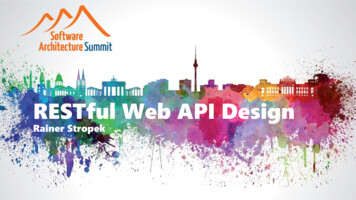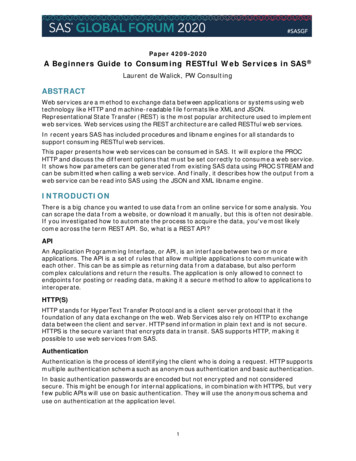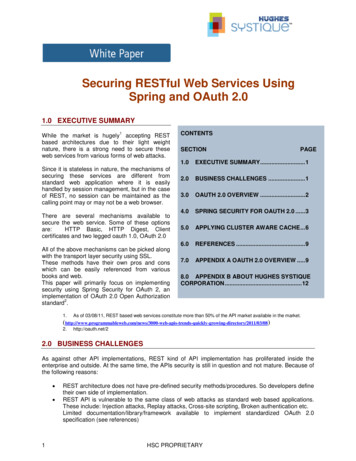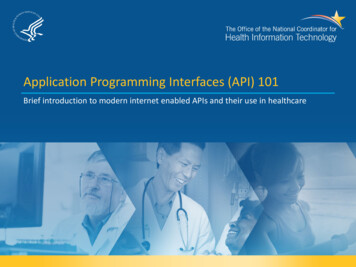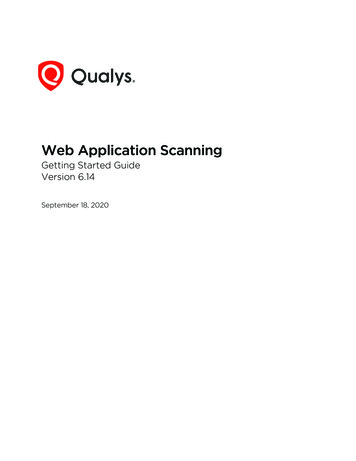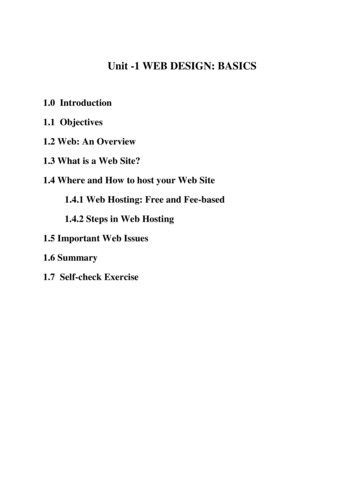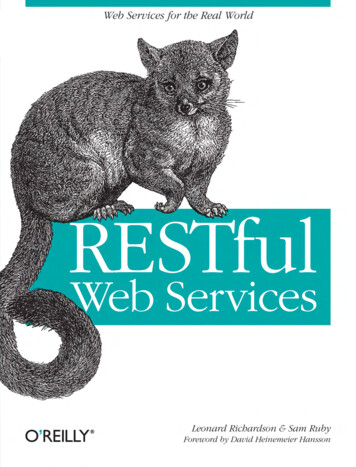
Transcription
RESTful Web Services
RESTful Web ServicesLeonard Richardson and Sam RubyBeijing Cambridge Farnham Köln Sebastopol Tokyo
RESTful Web Servicesby Leonard Richardson and Sam RubyCopyright 2007 O’Reilly Media. All rights reserved.Printed in the United States of America.Published by O’Reilly Media, Inc., 1005 Gravenstein Highway North, Sebastopol, CA 95472O’Reilly books may be purchased for educational, business, or sales promotional use. Online editionsare also available for most titles (http://safari.oreilly.com). For more information, contact our corporate/institutional sales department: (800) 998-9938 or corporate@oreilly.com.Editor: Mike LoukidesCopy Editor: Peggy WallaceProduction Editor: Laurel R.T. RumaProofreader: Laurel R.T. RumaIndexer: Joe WizdaCover Designer: Karen MontgomeryInterior Designer: David FutatoIllustrators: Robert Romano and Jessamyn ReadPrinting History:May 2007:First EditionNutshell Handbook, the Nutshell Handbook logo, and the O’Reilly logo are registered trademarks ofO’Reilly Media, Inc. The vulpine phalanger and related trade dress are trademarks of O’Reilly Media, Inc.Many of the designations uses by manufacturers and sellers to distinguish their products are claimed astrademarks. Where those designations appear in this book, and O’Reilly Media, Inc. was aware of atrademark claim, the designations have been printed in caps or initial caps.While every precaution has been taken in the preparation of this book, the publisher and authors assumeno responsibility for errors or omissions, or for damages resulting from the use of the information contained herein.ISBN: 978-0-596-52926-0[LSI]1302884426[2011-04-15]
For Woot, Moby, and Beet.—LeonardFor Christopher, Catherine, and Carolyn.—Sam
Table of ContentsForeword . . . . . . . . . . . . . . . . . . . . . . . . . . . . . . . . . . . . . . . . . . . . . . . . . . . . . . . . . . . . . . . . . . . xiPreface . . . . . . . . . . . . . . . . . . . . . . . . . . . . . . . . . . . . . . . . . . . . . . . . . . . . . . . . . . . . . . . . . . . . xiii1.The Programmable Web and Its Inhabitants . . . . . . . . . . . . . . . . . . . . . . . . . . . . . . . . . 1Kinds of Things on the Programmable WebHTTP: Documents in EnvelopesMethod InformationScoping InformationThe Competing ArchitecturesTechnologies on the Programmable WebLeftover Terminology2.Writing Web Service Clients . . . . . . . . . . . . . . . . . . . . . . . . . . . . . . . . . . . . . . . . . . . . . . 23Web Services Are Web Sitesdel.icio.us: The Sample ApplicationMaking the Request: HTTP LibrariesProcessing the Response: XML ParsersJSON Parsers: Handling Serialized DataClients Made Easy with WADL3.45811131820232629384447What Makes RESTful Services Different? . . . . . . . . . . . . . . . . . . . . . . . . . . . . . . . . . . . . 49Introducing the Simple Storage ServiceObject-Oriented Design of S3ResourcesHTTP Response CodesAn S3 ClientRequest Signing and Access ControlUsing the S3 Client LibraryClients Made Transparent with ActiveResourceParting Words495052545564707177vii
4.The Resource-Oriented Architecture . . . . . . . . . . . . . . . . . . . . . . . . . . . . . . . . . . . . . . . 79Resource-Oriented What Now?What’s a tionsLinks and ConnectednessThe Uniform InterfaceThat’s It!5.Designing Read-Only Resource-Oriented Services . . . . . . . . . . . . . . . . . . . . . . . . . . . 107Resource DesignTurning Requirements Into Read-Only ResourcesFigure Out the Data SetSplit the Data Set into ResourcesName the ResourcesDesign Your RepresentationsLink the Resources to Each OtherThe HTTP ResponseConclusion6.144157165A Service Implementation . . . . . . . . . . . . . . . . . . . . . . . . . . . . . . . . . . . . . . . . . . . . . . 167A Social Bookmarking Web ServiceFiguring Out the Data SetResource DesignDesign the Representation(s) Accepted from the ClientDesign the Representation(s) Served to the ClientConnect Resources to Each OtherWhat’s Supposed to Happen?What Might Go Wrong?Controller CodeModel CodeWhat Does the Client Need to Know?8.108109110112117123135137140Designing Read/Write Resource-Oriented Services . . . . . . . . . . . . . . . . . . . . . . . . . . 143User Accounts as ResourcesCustom PlacesA Look Back at the Map 87188205209REST and ROA Best Practices . . . . . . . . . . . . . . . . . . . . . . . . . . . . . . . . . . . . . . . . . . . . . 215Resource-Oriented Basicsviii Table of Contents215
The Generic ROA ProcedureAddressabilityState and StatelessnessConnectednessThe Uniform InterfaceThis Stuff MattersResource DesignURI DesignOutgoing RepresentationsIncoming RepresentationsService VersioningPermanent URIs Versus Readable URIsStandard Features of HTTPFaking PUT and DELETEThe Trouble with CookiesWhy Should a User Trust the HTTP 1252253The Building Blocks of Services . . . . . . . . . . . . . . . . . . . . . . . . . . . . . . . . . . . . . . . . . . 259Representation FormatsPrepackaged Control FlowsHypermedia Technologies25927228410. The Resource-Oriented Architecture Versus Big Web Services . . . . . . . . . . . . . . . . . 299What Problems Are Big Web Services Trying to Solve?SOAPWSDLUDDISecurityReliable MessagingTransactionsBPEL, ESB, and SOAConclusion30030030430931031131231331411. Ajax Applications as REST Clients . . . . . . . . . . . . . . . . . . . . . . . . . . . . . . . . . . . . . . . . . 315From AJAX to AjaxThe Ajax ArchitectureA del.icio.us ExampleThe Advantages of AjaxThe Disadvantages of AjaxREST Goes BetterMaking the RequestHandling the ResponseJSON315316317320321322323324325Table of Contents ix
Don’t Bogart the Benefits of RESTCross-Browser Issues and Ajax LibrariesSubverting the Browser Security Model32632733112. Frameworks for RESTful Services . . . . . . . . . . . . . . . . . . . . . . . . . . . . . . . . . . . . . . . . . 339Ruby on RailsRestletDjango339343355A.Some Resources for REST and Some RESTful Resources . . . . . . . . . . . . . . . . . . . . . . . 365B.The HTTP Response Code Top 42 . . . . . . . . . . . . . . . . . . . . . . . . . . . . . . . . . . . . . . . . . 371C.The HTTP Header Top Infinity . . . . . . . . . . . . . . . . . . . . . . . . . . . . . . . . . . . . . . . . . . . . 389Index . . . . . . . . . . . . . . . . . . . . . . . . . . . . . . . . . . . . . . . . . . . . . . . . . . . . . . . . . . . . . . . . . . . . . 409x Table of Contents
ForewordThe world of web services has been on a fast track to supernova ever since the architectastronauts spotted another meme to rocket out of pragmatism and into the universe ofenterprises. But, thankfully, all is not lost. A renaissance of HTTP appreciation isbuilding and, under the banner of REST, shows a credible alternative to what the merchants of complexity are trying to ram down everyone’s throats; a simple set of principles that every day developers can use to connect applications in a style native to theWeb.RESTful Web Services shows you how to use those principles without the drama, thebig words, and the miles of indirection that have scared a generation of web developersinto thinking that web services are so hard that you have to rely on BigCo implementations to get anything done. Every developer working with the Web needs to read thisbook.—David Heinemeier Hanssonxi
PrefaceA complex system that works is invariably found to haveevolved from a simple system that worked.—John GallSystemanticsWe wrote this book to tell you about an amazing new technology. It’s here, it’s hot,and it promises to radically change the way we write distributed systems. We’re talkingabout the World Wide Web.Okay, it’s not a new technology. It’s not as hot as it used to be, and from a technicalstandpoint it’s not incredibly amazing. But everything else is true. In 10 years the Webhas changed the way we live, but it’s got more change left to give. The Web is a simple,ubiquitous, yet overlooked platform for distributed programming. The goal of thisbook is to pull out that change and send it off into the world.It may seem strange to claim that the Web’s potential for distributed programming hasbeen overlooked. After all, this book competes for shelf space with any number of otherbooks about web services. The problem is, most of today’s “web services” have nothingto do with the Web. In opposition to the Web’s simplicity, they espouse a heavyweightarchitecture for distributed object access, similar to COM or CORBA. Today’s “webservice” architectures reinvent or ignore every feature that makes the Web successful.It doesn’t have to be that way. We know the technologies behind the Web can driveuseful remote services, because those services exist and we use them every day. Weknow such services can scale to enormous size, because they already do. Consider theGoogle search engine. What is it but a remote service for querying a massive databaseand getting back a formatted response? We don’t normally think of web sites as “services,” because that’s programming talk and a web site’s ultimate client is a human, butservices are what they are.Every web application—every web site—is a service. You can harness this power forprogrammable applications if you work with the Web instead of against it, if you don’tbury its unique power under layers of abstraction. It’s time to put the “web” back into“web services.”xiii
The features that make a web site easy for a web surfer to use also make a web serviceAPI easy for a programmer to use. To find the principles underlying the design of theseservices, we can just translate the principles for human-readable web sites into termsthat make sense when the surfers are computer programs.That’s what we do in this book. Our goal throughout is to show the power (and, whereappropriate, the limitations) of the basic web technologies: the HTTP application protocol, the URI naming standard, and the XML markup language. Our topic is the setof principles underlying the Web: Representational State Transfer, or REST. For thefirst time, we set down best practices for “RESTful” web services. We cut through theconfusion and guesswork, replacing folklore and implicit knowledge with concreteadvice.We introduce the Resource-Oriented Architecture (ROA), a commonsense set of rulesfor designing RESTful web services. We also show you the view from the client side:how you can write programs to consume RESTful services. Our examples include realworld RESTful services like Amazon’s Simple Storage Service (S3), the various incarnations of the Atom Publishing Protocol, and Google Maps. We also take popularservices that fall short of RESTfulness, like the del.icio.us social bookmarking API, andrehabilitate them.The Web Is SimpleWhy are we so obsessed with the Web that we think it can do everything? Perhaps weare delusional, the victims of hype. The web is certainly the most-hyped part of theInternet, despite the fact that HTTP is not the most popular Internet protocol. Depending on who’s measuring, the bulk of the world’s Internet traffic comes from email(thanks to spam) or BitTorrent (thanks to copyright infringement). If the Internet wereto disappear tomorrow, email is the application people would miss the most. So whythe Web? What makes HTTP, a protocol designed to schlep project notes around aphysics lab, also suited for distributed Internet applications?Actually, to say that HTTP was designed for anything is to pay it a pretty big compliment. HTTP and HTML have been called “the Whoopee Cushion and Joy Buzzer ofInternet protocols, only comprehensible as elaborate practical jokes”—and that’s bysomeone who likes them.*The first version of HTTP sure looked like a joke. Here’s asample interaction between client and server:Client requestServer responseGET /hello.txtHello, world!* Clay Shirky, “In Praise of Evolvable Systems” (http://www.shirky.com/writings/evolve.html)xiv Preface
That’s it. You connected to the server, gave it the path to a document, and then theserver sent you the contents of that document. You could do little else with HTTP 0.9.It looked like a featureless rip-off of more sophisticated file transfer protocols like FTP.This is, surprisingly, a big part of the answer. With tongue only slightly in cheek wecan say that HTTP is uniquely well suited to distributed Internet applications becauseit has no features to speak of. You tell it what you want, and it gives it to you. In a twiststraight out of a kung-fu movie,†HTTP’s weakness is its strength, its simplicity itspower.In that first version of HTTP, cleverly disguised as a lack of features, we can see addressability and statelessness: the two basic design decisions that made HTTP an improvement on its rivals, and that keep it scalable up to today’s mega-sites. Many of thefeatures lacking in HTTP 0.9 have since turned out to be unnecessary or counterproductive. Adding them back actually cripples the Web. Most of the rest were implemented in the 1.0 and 1.1 revisions of the protocol. The other two technologies essentialto the success of the Web, URIs and HTML (and, later, XML), are also simple in important senses.Obviously, these “simple” technologies are powerful enough to give us the Web andthe applications we use on it. In this book we go further, and claim that the WorldWide Web is a simple and flexible environment for distributed programming. We alsoclaim to know the reason for this: that there is no essential difference between thehuman web designed for our own use, and the “programmable web” designed for consumption by software programs. We say: if the Web is good enough for humans, it’sgood enough for robots. We just need to make some allowances. Computer programsare good at building and parsing complex data structures, but they’re not as flexible ashumans when it comes to interpreting documents.Big Web Services Are Not SimpleThere are a number of protocols and standards, mostly built on top of HTTP, designedfor building Web Services (note the capitalization). These standards are collectivelycalled the WS-* stack. They include WS-Notification, WS-Security, WSDL, and SOAP.Throughout this book we give the name “Big Web Services” to this collection of technologies as a fairly gentle term of disparagement.This book does not cover these standards in any great detail. We believe you can implement web services without implementing Big Web Services: that the Web shouldbe all the service you need. We believe the Web’s basic technologies are good enoughto be considered the default platform for distributed services.Some of the WS-* standards (such as SOAP) can be used in ways compatible with RESTand our Resource-Oriented Architecture. In practice, though, they’re used to† Legend of The Drunken Protocol (1991)Preface xv
implement Remote Procedure Call applications over HTTP. Sometimes an RPC styleis appropriate, and sometimes other needs take precedence over the virtues of the Web.This is fine.What we don’t like is needless complexity. Too often a programmer or a companybrings in Big Web Services for a job that plain old HTTP could handle just fine. Theeffect is that HTTP is reduced to a transport protocol for an enormous XML payloadthat explains what’s “really” going on. The resulting service is far too complex, impossible to debug, and won’t work unless your clients have the exact same setup as youdo.Big Web Services do have one advantage: modern tools can create a web service fromyour code with a single click, especially if you’re developing in Java or C#. If you’reusing these tools to generate RPC-style web services with the WS-* stack, it probablydoesn’t matter to you that a RESTful web service would be much simpler. The toolshide all the complexity, so who cares? Bandwidth and CPU are cheap.This attitude works when you’re working in a homogeneous group, providing servicesbehind a firewall for other groups like yours. If your group has enough political clout,you may be able to get people to play your way outside the firewall. But if you wantyour service to grow to Internet scale, you’ll have to handle clients you never plannedfor, using custom-built software stacks to do things to your service you never imaginedwere possible. Your users will want to integrate your service with other services you’venever heard of. Sound difficult? This already happens on the Web every day.Abstractions are never perfect. Every new layer creates failure points, interoperabilityhassles, and scalability problems. New tools can hide complexity, but they can’t justifyit—and they always add it. Getting a service to work with the Web as a whole meanspaying attention to adaptability, scalability, and maintainability. Simplicity—that despised virtue of HTTP 0.9—is a prerequisite for all three. The more complex the system,the more difficult it is to fix when something goes wrong.If you provide RESTful web services, you can spend your complexity on additionalfeatures, or on making multiple services interact. Success in providing services alsomeans being part of the Web instead of just “on” the Web: making your informationavailable under the same rules that govern well-designed web sites. The closer you areto the basic web protocols, the easier this is.The Story of the RESTREST is simple, but it’s well defined and not an excuse for implementing web servicesas half-assed web sites because “they’re the same.” Unfortunately, until now the mainREST reference was chapter five of Roy Fielding’s 2000 Ph.D. dissertation, which is agood read for a Ph.D. dissertation, but leaves most of the real-world questions unanswered. ‡That’s because it presents REST not as an architecture but as a way of judgingarchitectures. The term “RESTful” is like the term “object-oriented.” A language, axvi Preface
framework, or an application may be designed in an object-oriented way, but thatdoesn’t make its architecture the object-oriented architecture.Even in object-oriented languages like C and Ruby, it’s possible to write programsthat are not truly object-oriented. HTTP in the abstract does very well on the criteriaof REST. (It ought to, since Fielding co-wrote the HTTP standard and wrote his dissertation to describe the architecture of the Web.) But real web sites, web applications,and web services often betray the principles of REST. How can you be sure you’recorrectly applying the principles to the problem of designing a specific web service?Most other sources of information on REST are informal: mailing lists, wikis, andweblogs (I list some of the best in Appendix A). Up to now, REST’s best practices havebeen a matter of folklore. What’s needed is a concrete architecture based on the RESTmeta-architecture: a set of simple guidelines for implementing typical services that fulfill the potential of the Web. We present one such architecture in this book as theResource-Oriented Architecture (see Chapter 4). It’s certainly not the only possiblehigh-level RESTful architecture, but we think it’s a good one for designing web servicesthat are easy for clients to use.We wrote the ROA to bring the best practices of web service design out of the realmof folklore. What we’ve written is a suggested baseline. If you’ve tried to figure outREST in the past, we hope our architecture gives you confidence that what you’re doingis “really” REST. We also hope the ROA will help the community as a whole makefaster progress in coming up with and codifying best practices. We want to make it easyfor programmers to create distributed web applications that are elegant, that do the jobthey’re designed for, and that participate in the Web instead of merely living on top ofit.We know, however, that it’s not enough to have all these technical facts at your disposal. We’ve both worked in organizations where major architectural decisions didn’tgo our way. You can’t succeed with a RESTful architecture if you never get a chanceto use it. In addition to the technical know-how, we must give you the vocabulary toargue for RESTful solutions. We’ve positioned the ROA as a simple alternative to theRPC-style architecture used by today’s SOAP WSDL services. The RPC architectureexposes internal algorithms through a complex programming-language-like interfacethat’s different for every service. The ROA exposes internal data through a simpledocument-processing interface that’s always the same. In Chapter 10, we compare thetwo architectures and show how to argue for the ROA.‡ Fielding, Roy Thomas. Architectural Styles and the Design of Network-Based Software Architectures, Doctoraldissertation, University of California, Irvine, 2000 (http://www.ics.uci.edu/ fielding/pubs/dissertation/top.htm)Preface xvii
Reuniting the WebsProgrammers have been using web sites as web services for years—unofficially, ofcourse.§It’s difficult for a computer to understand web pages designed for human consumption, but that’s never stopped hackers from fetching pages with automated clientsand screen-scraping the interesting bits. Over time, this drive was sublimated into programmer-friendly technologies for exposing a web site’s functionality in officially sanctioned ways—RSS, XML-RPC, and SOAP. These technologies formed a programmableweb, one that extended the human web for the convenience of software programs.Our ultimate goal in this book is to reunite the programmable web with the humanweb. We envision a single interconnected network: a World Wide Web that runs onone set of servers, uses one set of protocols, and obeys one set of design principles. Anetwork that you can use whether you’re serving data to human beings or computerprograms.The Internet and the Web did not have to exist. They come to us courtesy of misallocated defense money, skunkworks engineering projects, worse-is-better engineeringpractices, big science, naive liberal idealism, cranky libertarian politics, technofetishism, and the sweat and capital of programmers and investors who thought they’dfound an easy way to strike it rich.The result is, amazingly, a simple, open (for now), almost universal platform for networked applications. This platform contains much of human knowledge and supportsmost fields of human endeavor. We think it’s time to seriously start applying its rulesto distributed programming, to open up that information and those processes to automatic clients. If you agree, this book will show you how to do it.What’s in This Book?In this book we focus on practical issues: how to design and implement RESTful webservices, and clients for those services. Our secondary focus is on theory: what it meansto be RESTful, and why web services should be more RESTful instead of less. We don’tcover everything, but we try to hit today’s big topics, and because this is the first bookof its kind, we return to the core issue—how to design a RESTful service—over andover again.The first three chapters introduce web services from the client’s perspective and showwhat’s special about RESTful services.§ For an early example, see Jon Udell’s 1996 Byte article “On-Line Componentware” (http://www.byte.com/art/9611/sec9/art1.htm). Note: “A powerful capability for ad hoc distributed computing arises naturally fromthe architecture of the Web.” That’s from 1996, folks.xviii Preface
Chapter 1, The Programmable Web and Its InhabitantsIn this chapter we introduce web services in general: programs that go over theWeb and ask a foreign server to provide data or run an algorithm. We demonstratethe three common web service architectures: RESTful, RPC-style, and REST-RPChybrid. We show sample HTTP requests and responses for each architecture, alongwith typical client code.Chapter 2, Writing Web Service ClientsIn this chapter we show you how to write clients for existing web services, usingan HTTP library and an XML parser. We introduce a popular REST-RPC service(the web service for the social bookmarking site del.icio.us) and demonstrate clients written in Ruby, Python, Java, C#, and PHP. We also give technology recommendations for several other languages, without actually showing code. JavaScript and Ajax are covered separately in Chapter 11.Chapter 3, What Makes RESTful Services Different?We take the lessons of Chapter 2 and apply them to a purely RESTful service:Amazon’s Simple Storage Service (S3). While building an S3 client we illustratesome important principles of REST: resources, representations, and the uniforminterface.The next six chapters form the core of the book. They focus on designing and implementing your own RESTful services.Chapter 4, The Resource-Oriented ArchitectureA formal introduction to REST, not in its abstract form but in the context of aspecific architecture for web services. Our architecture is based on four importantREST concepts: resources, their names, their representations, and the links between them. Its services should be judged by four RESTful properties: addressability, statelessness, connectedness, and the uniform interface.Chapter 5, Designing Read-Only Resource-Oriented ServicesWe present a procedure for turning an idea or a set of requirements into a set ofRESTful resources. These resources are read-only: clients can get data from yourservice but they can’t send any data of their own. We illustrate the procedure bydesigning a web service for serving navigable maps, inspired by the Google Mapsweb application.Chapter 6, Designing Read/Write Resource-Oriented ServicesWe extend the procedure from the previous chapter so that clients can create,modify, and delete resources. We demonstrate by adding two new kinds of resource to the map service: user accounts and user-defined places.Chapter 7, A Service ImplementationWe remodel an RPC-style service (the del.icio.us REST-RPC hybrid we wrote clients for back in Chapter 2) as a purely RESTful service. Then we implement thatservice as a Ruby on Rails application. Fun for the whole family!Preface xix
Chapter 8, REST and ROA Best PracticesIn this chapter we collect our earlier suggestions for service design into one place,and add new suggestions. We show how standard features of HTTP can help youwith common problems and optimizations. We also give resource-oriented designsfor tough features like transactions, which you may have thought were impossibleto do in RESTful web services.Chapter 9, The Building Blocks of ServicesHere we describe extra technologies that work on top of REST’s big three of HTTP,URI, and XML. Some of these technologies are file formats for conveying state, likeXHTML and its microformats. Some are hypermedia formats for showing clientsthe levers of state, like WADL. Some are sets of rules for building RESTful webservices, like the Atom Publishing Protocol.The last three chapters cover specialized topics, each of which could make for a bookin its own right:Chapter 10, The Resource-Oriented Architecture Versus Big Web ServicesWe compare our architecture, and REST in general, to another leading brand. Wethink that RESTful web services are simpler, more scalable, easier to use, betterattuned to the philosophy of the Web, and better able to handle a wide variety ofclients than are services based on SOAP, WSDL, and the WS-* stack.Chapter 11, Ajax Applications as REST ClientsHere we explain the Ajax architecture for web applications in terms of web services:an Ajax application is just a web service client that runs inside your web browser.That makes this chapter an extension of Chapter 2. We show how to write clientsfor RESTful web services using XMLHttpRequest and the standard JavaScript library.Chapter 12, Frameworks for RESTful ServicesIn the final chapter we cover three popular frameworks that make it easy to implement RESTful web services: Ruby on Rails, Restlet (for Java), and Django (forPython).We also have three appendixes we hope you find useful:Appendix A, Some Resources for REST and Some RESTful ResourcesThe first part lists interesting standards, tutorials, and communities related toRESTful web services. The second part lists some existing, public RESTful webservices that you can use and learn from.Appendix B, The HTTP Response Code Top 42Describes every standard HTTP response code (plus one extension), and explainswhen you’d use each one in a RESTful web service.Appendix C, The HTTP Header Top InfinityDoes the same thing for HTTP headers. It covers every standard HTTP header,and a few extension headers that are useful for web services.xx Preface
Which Parts Should You Read?We organized this book for the reader who’s interested in web services in general:someone who learns by doing, but who doesn’t have much experience with web services. If that describes you, the simplest path through this book is the best. You can startat the beginning, read through Chapter 9, and then read onward as you’re interested.If you have more experience, you might take a different path through the book. If you’reonly concerned with writing clients for existing services, you’ll probably focus onChapters 1, 2, 3, and 11—the sections on service design won’t do you much good. Ifyou want to create your own web service, or you’re trying to figure out what RESTreally means, you might start reading from Chapter 3. If you want to compare RESTto the WS-* technologies, you might start by reading Chapters 1, 3, 4, and 10.Administrative NotesThis book has two authors (Leonard and Sam), but for the rest of the book we’ll bemerging our identities into a single authorial “I.” In the final chapter (Chapter 12), theauthorial “I” gets a little bit more crowded, as Django and Restlet developers join in toshow how their frameworks let you build RESTful services.We assume that you’re a competent programmer, but not that you have any experiencewith web programming in particular. What we say in this book is not tied to any programming language, and we include sample code for RESTful clients and services in avariety of languages.
book is to pull out that change and send it off into the world. It may seem strange to claim that the Web’s potential for distributed programming has been overlooked. After all, this book competes for shelf space with any number of other books about web services. The problem is, most

